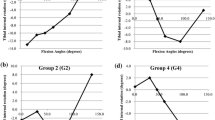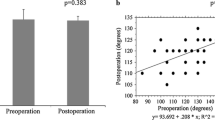Abstract
Purpose
To investigate intraoperative kinematics during passive flexion using a surgical navigation system for knees undergoing posterior stabilized (PS) total knee arthroplasty (TKA) with an asymmetric helical post-cam design using navigation system.
Methods
In total, 45 knees with both pre- and postoperative kinematic data available were included in the study. Intraoperative kinematic measurements were performed during the course of surgery using the software incorporated in the navigation system. Measurements were performed at the following two time points: (1) before TKA procedure and (2) after TKA implantation. Among the kinematic parameters studied, anterior/posterior translation and axial rotation during flexion were subjected to the analysis.
Results
Before surgery, physiologic anterior/posterior translational pattern of the tibia during flexion (rollback of the femur) was found in only 15.6% of the knees. After TKA implantation, postoperative kinematic measurement showed no significant change in the tibial translational during knee flexion. Similarly, with regard to rotation, non-physiologic external tibial rotation in early flexion was observed in the majority of the knees before surgery, and this abnormal kinematic pattern remained after the TKA procedure.
Conclusions
The intraoperative three-dimensional motion analysis using a navigation system showed that the physiologic kinematic pattern (anterior translation and internal rotation of the tibia during flexion) of the knee was distorted in osteoarthritic knees undergoing TKA. The abnormal kinematic pattern before surgery was not fully corrected even after implantation of the PS TKA designed to induce natural knee motion; however, no clear relationship between the intraoperative kinematic pattern and knee flexion angle at one year was demonstrated, and the effect of knee kinematics on postoperative knee function and patient’s satisfaction is still unclear.




Similar content being viewed by others
References
Siston RA, Giori NJ, Goodman SB et al (2006) Intraoperative passive kinematics of osteoarthritics knee before and after total knee arthroplasty. J Orthop Res 24(8):1607–1614
Nishio Y, Onodera T, Kasahara Y et al (2014) Intraoperative medial pivot affects deep knee flexion angle and patient-reported outcomes after total knee arthroplasty. J Arthroplast 29(4):702–706
Victor J, Bellemans J (2006) Physiologic kinematics as a concept for better flexion in TKA. Clin Orthop Rel Res 452:53–58
Banks SA, Hodge WA (1996) Accurate measurement of three-dimensional knee replacement kinematics using single-plane fluoroscopy. IEEE Trans Biomed Eng 43(6):638
Hoff WA, Komistek RD, Dennis DA et al (1998) Three-dimensional determination of femoral-tibial contact positions under in vivo conditions using fluoroscopy. Clin Biomech 13:455
Dennis DA, Komistek RD, Mahfouz MR, Haas BD, Stiehl JB (2003) Multicenter determination of in vivo kinematics after total knee arthroplasty. Clin Orthop Relat Res 416:37
Banks SA, Hodge WA (2004) Implant design affects knee arthroplasty kinematics during stair-stepping. Clin Orthop Relat Res 426:187
Delp SL, Stulberg D, Davies B et al (1998) Computer assisted knee replacement. Clin Orthop Relat Res 354:49–56
Fritzsche H, Beyer F, Postler A et al (2018) Different intraoperative kinematics, stability, and range of motion between cruciate substituting ultracongruent and posterior-stabilized total knee arthroplasty. Knee Surg Sports Traumatol Arthrosc 26(5):1465–1470
Ishida K, Shibanuma N, Matsumoto T et al (2016) Navigation-based femorotibial rotation pattern correlated with flexion angle after total knee arthroplasty. Knee Surg Sports Traumatol Arthrosc 24:89–95
Ishida K, Shibanuma N, Matsumoto T et al (2015) Factors affecting intraoperative kinematic patterns and flexion angles in navigated total knee arthroplasty. Knee Surg Sports Traumatol Arthrosc 23(6):1741–1747. https://doi.org/10.1007/s00167-015-3572-1
Kim TW, Lee SM, Seong SC et al (2016) Different intraoperative kinematics with comparable clinical outcomes of ultracongruent and posterior stabilized mobile-bearing total knee arthroplasty. Knee Surg Sports Traumatol Arthrosc 24(9):3036–3043
Matsumoto T, Takayama K, Muratsu H et al (2015) Semimembranosus release reduces tibial internal rotation and flexion angle in cruciate-retaining total knee arthroplasty. J Arthroplast 30(9):1537
Seito N, Onodera T, Kasahara Y et al (2017) Preoperative knee deformity and kinematics impact postoperative knee kinematics in total knee arthroplasty. Knee 124(6):1462–1468
Seon JK, Park JK, Jeong MS, Jung WB et al (2011) Correlation between preoperative and postoperative knee kinematics in total knee arthroplasty using cruciate retaining designs. Int Orthop 35(4):515–520. https://doi.org/10.1007/s00264-010-1029-1
Allain J, Goutallier D, Voisin MC (2001) Macroscopic and histological assessments of the crusiate ligaments in arthrosis of the knee. Acta Orthop Scand 72(3):266–269
Akagi M, Mori S, Nishimura S et al (2005) Variability of extraarticular tibial rotation references for total knee arthroplasty. Clin Orthop Relat Res 436:172
Kaufman L, Rousseeuw PJ (1990) Finding groups in data: an introduction to cluster analysis. Wiley, New York
Iwaki H, Pinskerova V, Freeman MA (2000) Tibiofemoral movement 1: the shapes and relative movements of the femur and tibia in the unloaded cadaver knee. J Bone Joint Surg Br 82(8):1189–1195
Freeman MA, Pinskerova V (2005) The movement of the normal tibio-femoral joint. J Biomech 38(2):197–208
Dennis DA, Mahfouz MR, Komistek RD, Hoff W (2005) In vivo determination of normal and anterior cruciate ligament-deficient knee kinematics. J Biomech 38(2):241–253
Kurosawa H, Walker PS, Abe S, Garg A, Hunter T (1985) Geometry and motion of the knee for implant and orthotic design. J Biomech 18(7):487–499
Casino D, Zaffagnini S, Martelli S et al (2009) Intraoperative evaluation of total knee replacement: kinematic assessment with a navigation system. Knee Surg Sports Traumatol Arthrosc 17(4):369
Baier C, Springorum HR, Götz J et al (2013) Comparing navigation-based in vivo knee kinematics pre- and postoperatively between a cruciate-retaining and a cruciate-substituting implant. Int Orthop 37(3):407
Young KL, Dunbar MJ, Richardson G et al (2015) Intraoperative passive knee kinematics during total knee arthroplasty surgery. J Orthop Res 33(11):1611
Jenny JY, Boeri C (2004) Low reproducibility of the intra-operative measurement of the transepicondylar axis during total knee replacement. Acta Orthop Scand 75(1):74
Author information
Authors and Affiliations
Corresponding author
Ethics declarations
Conflict of interest
The authors declare that they did not receive and will not receive any benefits or funding from any commercial party related directly or indirectly to the subjects of this article.
Ethical standard
All procedures performed in studies involving human participants were in accordance with the ethical standards of the institutional research committee and with the 1964 Declaration of Helsinki and later amendments or comparable ethical standards.
Rights and permissions
About this article
Cite this article
Morooka, T., Okuno, M., Seino, D. et al. Intraoperative kinematic analysis of posterior stabilized total knee arthroplasty with asymmetric helical post-cam design. Eur J Orthop Surg Traumatol 29, 675–681 (2019). https://doi.org/10.1007/s00590-018-2318-4
Received:
Accepted:
Published:
Issue Date:
DOI: https://doi.org/10.1007/s00590-018-2318-4




